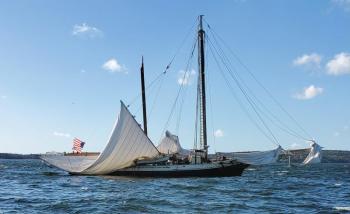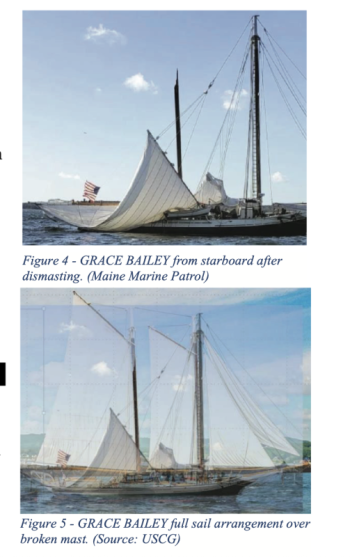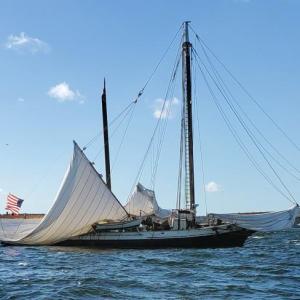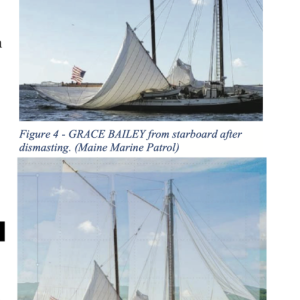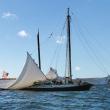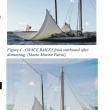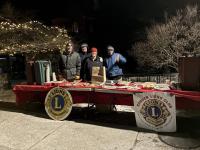Coast Guard releases report on schooner demasting, death of passenger, analysis of vessel's rigging
PENOBSCOT BAY — Almost two years ago, Oct. 9, 2023, a mast on the Grace Bailey schooner broke and fell, killing passenger Emily Mecklenburg, a physician at Pen Bay Medical Center, in Rockport.
Three other patients were transported from the U.S. Coast Guard pier, with two taken to Pen Bay Medical Center in Rockport, and one to an awaiting LifeFlight helicopter.
The Coast Guard Northeast District Commander convened a formal investigation, and on July 9, 2025, the Coast Guard’s Office of Investigations and Casualty Analysis report of investigation (ROI) was released to Marine Casualty Report.
The tragedy occured at 10:12 a.m. Oct. 9, as the Grace Bailey was leaving Gilkey Harbor, on Islesboro, and heading back to homeport in Rockland. Winds were estimated at 20 knots. As the Grace Bailey was preparing to come about and shift to a starboard tack, passengers and crew heard noises from the mast.
"The captain and mate scanned the rig, finding the mainmast bending at a point approximately 75 percent up the mast," the report said. "Without delay, the captain ordered everyone to get down. As he did, the mainmast collapsed, twisting, and falling to starboard."
Emily Mecklenburg was apparently seated on the forward starboard corner of the forward/midship cabin top.
"She is believed to have been struck across the head and back by the falling mainmast," the report said, noting her only as Passenger 5. "The impact knocked her to the deck between the forward and forward/midship cabin tops."
Other passenger injured were described as suffering:
"(Passenger #1) was seated on the starboard aft portion of the forward cabin top, facing outboard to starboard. She was struck on the back by the lower portion of the mainmast. After being struck she remained seated/lying on the cabin top.
"(Passenger #2) and (Passenger #3) were both seated on the starboard side of the aft cabin top directly beneath the mainmast boom. Both were struck across the shoulders and neck by the falling boom. (Passenger #2) was knocked out of the way of the boom, while (Passenger #3) was pinned in a partially seated position on the aft cabin top with the boom across his shoulders.
"(Passenger #4) was seated on the starboard side of the forward/midship cabin top directly in front of the mainmast. He was facing outboard to starboard. He is believed to have been struck by the falling gaff, which knocked him off the cabin top and to the deck.
"(Passenger #6) was standing in the companionway in the vicinity of the galley ladder. While evading falling material, she fell down the ladder, landing in the galley."
After an analysis of records and of the schooner itself, the investigation team compiled and issued nine safety recommendations and two administrative recommendations, according to the Coast Guard.
The Coast Guard did not recommend administrative or punitive action be taken against any Coast Guard personnel.
"It is not recommended that suspension or revocation action be taken against any credentialed mariner," the report said. "Additionally, it is not recommended that criminal prosecution be taken against any person or entity."
But the recommendations do call for increased monitoring and inspections of wooden sailing vessels.
"There are currently more than 275 sailing vessels certificated to operate as small passenger vessels and approximately 110 of those vessels have wooden hulls," the report said. "The Coast Guard will survey those wood vessels to determine the implementation status of Preventative Maintenance Plans and to also obtain better data on spar material (i.e., wood versus non-wood), spar construction (i.e., grown vs built), and spar age."
Recommendation 1:
It is recommended that Commandant direct broad collaboration with sailing industry organizations such as Tall Ships America, as well as marine surveyors and the U.S. Forest Service (USFS) Forest Products Laboratory (FPL) to identify wooden mast material characteristics and conditions that can precede, influence, or contribute to fungal decay. In addition to those items listed in Navigation and Vessel Inspection Circular (NVIC) 02-16 Appendix (10) to Enclosure (1) and NVIC 07-95 Chapter 4, potentially relevant characteristics, and conditions, amongst many others, might include species, age, geographic harvest region, seasoning method and results, preservative treatment type and method, area of operation, moisture intrusion points and moisture content, and previous decay.
Recommendation 2:
It is recommended that Commandant direct broad collaboration with sailing industry organizations such as Tall Ships America, as well as marine surveyors and the US Forest Service (USFS) Forest Products Laboratory (FPL) to determine which, if any material characteristics identified by Recommendation #1 can be reasonably monitored as part of a Preventive Maintenance Plan. Where feasible, develop inspection and documentation guidance to assist owners and inspectors with detecting and recording changes or stability of these conditions over time.
Recommendation 3:
It is recommended that Commandant direct policy and/or guidance updates to require the collection and standardized recording of wooden mast material characteristics and conditions identified by Recommendation #1 within a vessel’s permanent Marine Information for Safety and Law Enforcement (MISLE) record. Additionally, stability or changes of those items which can be reasonably evaluated as determined by Recommendation #2 should be recorded in a standardized format following each inspection. NVIC 02-16 Enclosure (1) III.a.iv.1 already requires marine inspectors to provide a “Detailed description of the rig and associated gear” within MISLE or a vessel’s permanent file upon completion of an annual exam.
The intent of this recommendation is to provide wood mast specific guidance to supplement this record keeping requirement and to ensure that all potentially hazardous mast conditions are evaluated at each inspection.
Recommendation 4:
It is recommended that Commandant direct broad collaboration with sailing industry organizations such as Tall Ships America, as well as marine surveyors and the U.S. Forest Service (USFS) Forest Products Laboratory (FPL), to evaluate non-destructive testing technologies, including internal moisture detection, and determine which, if any, are suitable for wood mast inspections. It is further recommended that Commandant direct a review of the newly formalized sail and rigging course for marine inspectors, course code 100439, and update as necessary to ensure all suitable non-destructive testing methods and their appropriate uses are adequately covered.
Recommendation 5:
It is recommended that Commandant direct broad collaboration with sailing industry organizations such as Tall Ships America, as well as marine surveyors and the U.S. Forest Service Forest Products Laboratory to assess the current 10-year unstepping interval guidance for wood masts in Navigation and Vessel Inspection Circular (NVIC) 02-16 and revise if warranted.
Recommendation 6:
It is recommended that Commandant direct broad collaboration with sailing industry organizations such as Tall Ships America, as well as marine surveyors and the U.S. Forest Service (USFS) Forest Products Laboratory (FPL) to evaluate industry established best practices for conducting wood mast inspections. This information should be consolidated, revised if necessary, and distributed to commercial sail vessel operators and marine inspectors by the most efficient means available.
Recommendation 7:
It is recommended that Commandant direct broad collaboration with sailing industry organizations such as Tall Ships America, as well as marine surveyors and U.S. Forest Service (USFS) Forest Products Laboratory (FPL) to review existing training guidance for crew members who are involved with wood mast inspections. This information should be consolidated, revised if necessary, and distributed to commercial sail vessel operators and marine inspectors by the most efficient means available.
Recommendation 8:
It is recommended that Commandant direct a review of Preventive Maintenance Plan implementation status across the Coast Guard, track industry achievement of the recommended practices, and initiate outreach to improve adherence if warranted.
Administrative Recommendation 1: It is recommended that Coast Guard District One consider appropriate recognition for GRACE BAILEY passengers and Good Samaritans who provided immediate emergency medical response for injured persons.
In the analysis section of the report, it was noted that the main mast and fore mast on the Grace Bailey had been purchased and installed in 1993 after the Coast Guard issued a requirement to replace the foremast in 1991.
"This led to extensive correspondence between the owner and the Coast Guard from 1991 to 1993, resulting in a comprehensive record of the new mast's material specifications, which would not typically be maintained by the Coast Guard," the report said.
The report noted in its analysis section about wood rot that the vessel's main mast exhibited signs of rot along a 48-foot section, starting 12 feet above the base and extending upwards to 60 feet above the base.
The report said in its analysis section:
"Prior Owner/Operator Preservation, Maintenance, and Inspections (1993-2022)
"Lack of a formal maintenance and inspection program. The vessel’s prior owner did not have a formally established mast maintenance or inspection program in place. This absence of a structured program meant there was no systematic approach to monitor the condition of the masts. The lack of a formalized routine contributed to unidentified degradation of the mast over time.
"Limited mast maintenance. Mast maintenance was limited to bi-annual slushing performed by the crew. While slushing can help protect the mast from moisture and decay, it is insufficient on its own to address underlying structural issues. Without thorough inspections accompanying the slushing, deterioration went unnoticed and unaddressed.
Limited crew training. Crew members were expected to inspect the masts visually during bi-annual slushing. However, they were not trained in specific mast or wood inspection procedures. This lack of training and knowledge meant that inspections were superficial, and crew members were not equipped to identify deeper structural issues.
"Visual observations without proper tools. The limited mast inspections conducted by crew members were primarily based on visual observations, which resulted in superficial assessments. The crew did not utilize phenolic hammers for sounding, moisture meters, or probing tools that would extend to the deepest recesses of a check, all of which make up current 'industry established best practice'. The absence of traditional wood assessment tools increased the likelihood of structural issues being overlooked.
"Lack of documentation. There was no documentation for inspections conducted by the crew. The absence of documented records hindered traceability and accountability. This lack of documentation made it challenging for the owner to track the vessel's maintenance history, identify trends, and ensure proactive correction of underlying structural deficiencies in the masts.
"Reliance on Coast Guard inspections. The prior owner primarily relied on inspections by the Coast Guard, conducted annually and at 10-year intervals. The Coast Guard holds statutory authority and responsibility to establish and execute vessel inspection procedures (see 6.2.4.1). While these external inspections provided some oversight, their limited frequency meant they could not capture all potential issues and identifiable flaws between inspections. While the Coast Guard is required to carry out statutory inspection requirements, masters, owners, or other responsible parties are required by statute to maintain inspected vessels to always be in compliance with applicable regulations, which includes maintaining the vessel in accordance with industry standards and good marine practice. (see 6.2.4.2).
"Preference to leave mast checks open. The prior owner preferred to leave mast checks open, intending to prevent water entrapment and promote drainage. However, post-casualty evaluations revealed that most of these checks were filled with a wax/oil-based material, rendering the intention to promote proper drainage ineffective and potentially concealing underlying issues."
"Current Owner/Operator Preservation, Maintenance, and Inspections (2022-2023)
"Delegated responsibility and limited training of the mate. The operator delegated responsibility for mast and rigging inspections to the mate.
Although the mate had prior experience, they lacked formal training in mast and wood inspection. This delegation without proper training led to several issues. While the mate conducted inspections monthly, the absence of formal training and adequate guidance likely compromised the thoroughness and accuracy of these assessments. Inspections were conducted visually without the use of sounding hammers or probing tools. This limitation meant that underlying structural issues, such as internal rot or decay, could go undetected, increasing the risk of mast failure.
"Inadequate documentation and record-keeping. The vessel's mast maintenance and inspection documentation practices were notably inadequate.
"There were no specific record-keeping requirements, leading to inconsistent logging of inspections. The logs that were kept lacked detailed information regarding the scope of inspections, findings, and the conditions observed.
"This inconsistency limited the utility of the records for tracking maintenance history and identifying emerging issues.
"Insufficient oversight and reporting. There was a lack of oversight and formal reporting mechanisms related to the operator’s internal mast inspectionprocesses. Inspections were not adequately documented, and there were no formal expectations set for reporting inspection findings. This lack of oversight likely contributed to delayed or inadequate responses to emerging issues, allowing hazards to persist and escalate unchecked.
"Reliance on Coast Guard inspections. As with the prior owner, the current owner relied on inspections by the Coast Guard, conducted annually and at 10-year intervals (see 7.3.7, 6.2.4.1, and 6.2.4.2)."
The report noted:
"Coast Guard reliance on owner, operator, and third-party reports. MSD Belfast inspectors reported historic reliance on owners, operators, and third-party surveyors to identify and report rotted conditions in masts. This does not mean that MSD Belfast delegated mast inspections to other entities. Rather, it means despite the annual inspections conducted by MSD Belfast, all rotted mast conditions captured in permanent records were identified by another entity and reported to the Coast Guard, rather than being found by Coast Guard inspectors. Historic mast deficiency reporting by owners, operators and surveyors reflects positively on inspector collaboration with industry professionals, but this approach falls short when owners are not diligent in their internal assessments."
Reach Editorial Director Lynda Clancy at lyndaclancy@penbaypilot.com; 207-706-6657



